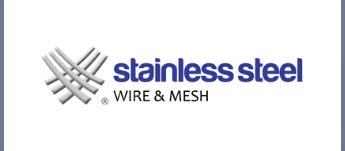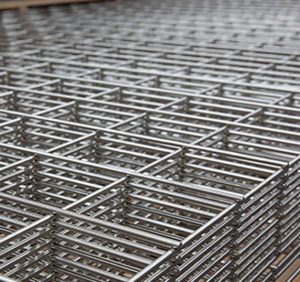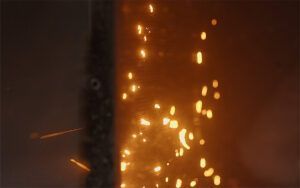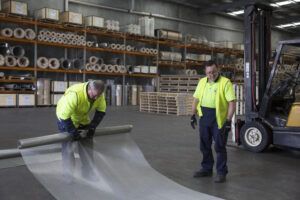Stainless Steel is becoming more prevalent around the globe as an alternative material to use for civil projects and reinforcing mesh. In 1990, the UK updated their BA 84/02 Design Manual for Roads and Bridges to enforce the use of stainless steel in concrete reinforcement. This is due to the previous material causing corrosion issues – and stainless steel was chosen as the replacement steel due to its corrosion resistance, amongst other factors. But why is carbon steel the most common choice in Australia? Why is stainless steel not used more for projects here in Australia?
What is Stainless Steel Reinforcing Mesh?
Stainless Steel is a generic term for a family of corrosion resistant iron (FE) based alloys containing 10.5% or more chromium (Cr). Chromium produces a thin layer of oxide on the surface of the steel known as a passive layer. Other elements such as molybdenum (MO) and nitrogen (N) further strengthen the passive film and improve corrosion resistance.
Reinforcing mesh is used to improve the tensile strength of concrete and prevents cracks to structural elements. Stainless steel provides a more sustainable choice, than traditional carbon steel reinforcing mesh. Stainless steel reinforcing mesh is commonly used for a range of applications in corrosive environments, and it is mainly used in structures that require a long life and where future maintenance or access is difficult, such as for critical concrete structures and infrastructure that require a long life such as bridges, tunnels, and piers
What are the benefits of Reinforcing Mesh?
Stainless steel is the optimum solution for reinforcing mesh in corrosive environments and critical structures and infrastructure for the following reasons:
- Reduces concrete cover
- Eliminates concrete sealant
- Reduces maintenance and repairs costs
- Damage resistance and easy handling, bending & welding during construction
- Cost effective choice for where future maintenance or access is difficult
- Reduced life cycle costing
Lifecycle Costing is an important consideration for reinforcing mesh
Lifecycle costing is a formula that assesses the total cost of an asset over its life cycle including initial capital costs, maintenance costs, operating costs, and the asset’s residual value at the end of its life.
Factors that improve the life cycle costing for reinforcing mesh are:
- Tolerates poor workmanship (insufficient concrete cover, poor compaction, inadequate curing…)
- Insensitive to poor concrete quality
- Easy installation
- No maintenance
- No life limit
- Allows a thinner concrete cover
- Better fire resistance
- 100% Recycled
Case Study – Broadmeadow Estuary Bridge
Reinforcing mesh is mainly used for bridges, tunnels, pi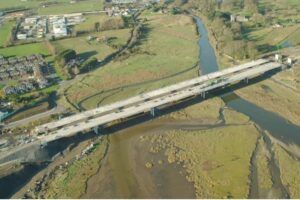
The bridge was designed with stainless steel to help enhance service life and provide further assurance to the structural integrity. Additionally, the stainless-steel rebar also provides a passive nature in resisting corrosion.
To learn more about this project, visit The Institution of Engineers of Ireland Civil Division
Case Study – Kingsford Smith Drive
Another instance of stainless steel reinforcing mesh, is the upgrade of Kingsford Smith Drive, Brisbane. Stainless steel was chosen specifically due its resistance to chloride attack, pitting corrosion, and its service life of 100 years.
To learn more about this project, visit ASSDA
Case Study – Bathers Way Project
A coastal walk along beaches in Newcastle, New South Wales, used stainless steel reinforcing mesh, 316L as its main construction material due to its sustainable, corrosion resistance and ductile properties. The cliff top location of the walkway overlooking the Pacific Ocean, was also a determining factor given the high wind and salt exposure.
For more information on this, visit ASSDA
So, why aren’t more projects in Australia using stainless steel welded mesh as reinforcing in concrete?
People don’t know how easy it is to make the change! Due to stainless steels long-lasting life, its material properties, and its proven global usage in projects – stainless steel reinforcing mesh is the number one option for reinforcing concrete! SSWM are leading stainless steel innovators – and their reinforcing mesh is grade 316L stainless steel. It also meets the chemical composition standard of BS-6744 and mechanical properties standard of AS-4671-2019.
For Further Information on Reinforcing Mesh:
- SSWM Reinforcing Mesh
- Stainless Steel Rebar – An international website for stainless steel rebar information – provided by industry experts.
- Nickel Institute – A website that provides information and support regarding Nickel usage
- Australian Stainless Steel Development Association (ASSDA) – An association that provides education and training for stainless steel.
